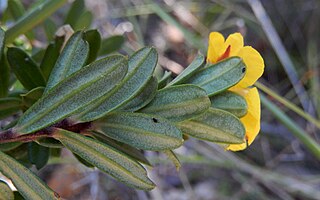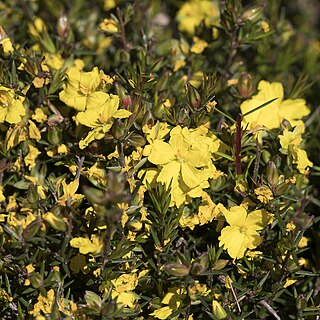
Hibbertia sericea, commonly known as silky guinea-flower, is a species of flowering plant in the family Dilleniaceae and is endemic to south-eastern Australia. It is an erect or spreading shrub with softly-hairy branches, elliptic to egg-shaped leaves with the narrower end towards the base, and yellow flowers with eight to fourteen stamens in a cluster on one side of two hairy carpels.

Hibbertia riparia, commonly known as erect guinea-flower, is a species of flowering plant in the family Dilleniaceae and is endemic to the south-eastern Australia. It is an erect to spreading shrub with hairy foliage, linear leaves and yellow flowers with six to sixteen stamens in a single cluster on one side of two carpels.

Hibbertia stricta is a species of flowering plant in the family Dilleniaceae and is endemic to New South Wales. It is a small, usually upright shrub with hairy foliage, linear leaves and yellow flowers with six or seven stamens arranged around two woolly-hairy carpels.

Hibbertia vestita, commonly known as hairy guinea-flower, is a species of flowering plant in the family Dilleniaceae and is endemic to eastern Australia. It is a small shrub with foliage covered with simple hairs, usually linear leaves, and yellow flowers with 22 to 43 stamens with many staminodes arranged around three hairy carpels.

Hibbertia bracteata is a species of flowering plant, in the family Dilleniaceae, and is endemic to eastern New South Wales. It is a shrub with lance-shaped to oblong leaves and yellow flowers with about sixteen stamens arranged on one side of the two carpels.

Hibbertia acicularis, commonly known as prickly guinea-flower, is a species of flowering plant in the family Dilleniaceae and is endemic to eastern Australia. It is an erect or prostrate shrub with linear to lance-shaped leaves and yellow flowers arranged singly in leaf axils with the six to eight stamens joined at the base, in a single cluster.
Hibbertia brennanii is a species of flowering plant in the family Dilleniaceae and is endemic to the Arnhem Land escarpment. It is a low, spreading sub-shrub with hairy foliage, elliptic to lance-shaped leaves and pale yellow flowers arranged singly in leaf axils, with ten to twelve stamens arranged in groups around the two carpels.
Hibbertia brevipedunculata is a species of flowering plant in the family Dilleniaceae and is endemic to northern Australia. It is a sub-shrub with hairy foliage, linear to lance-shaped leaves with the narrow end towards the base, and yellow flowers arranged singly on the ends of branches or short side shoots, with thirty to forty-four stamens arranged in bundles around the two carpels.
Hibbertia cinerea is a species of flowering plant in the family Dilleniaceae and is endemic to the southern part of the Eyre Peninsula in South Australia. It is a densely-branched, hairy shrub with narrow elliptic to lance-shaped leaves, and yellow flowers arranged on the ends of branchlet, with nine to twelve stamens arranged in a group on one side of the two carpels.
Hibbertia cistifolia is a species of flowering plant in the family Dilleniaceae and is endemic to northern Australia. It is a prostrate to low-lying sub-shrub with trailing, wiry stems, hairy foliage, oblong to elliptic leaves and yellow flowers arranged in leaf axils, with forty to fifty-eight stamens arranged around the two carpels.

Hibbertia decumbens is a species of flowering plant in the family Dilleniaceae and is endemic to a restricted area of New South Wales. It is a spreading, almost prostrate shrub with hairy foliage, egg-shaped to almost round leaves, and yellow flowers usually with nine to twelve stamens arranged in a group on one side of two carpels.

Hibbertia elata is a species of flowering plant in the family Dilleniaceae and is endemic to a eastern Australia. It is an open shrub with hairy stems, clustered, narrow linear to narrow lance-shaped leaves with the narrower end towards the base, and yellow flowers usually with fifteen to twenty-five stamens arranged around the three carpels.

Hibbertia exutiacies is a species of flowering plant in the family Dilleniaceae and is endemic to Australia. It is a small, spreading to low-lying shrub with linear leaves that are triangular in cross-section, and yellow flowers with four to eight stamens arranged in a single cluster on one side of the two carpels.
Hibbertia hirta is a species of flowering plant in the family Dilleniaceae and is endemic to the Budawang Range in New South Wales. It is a shrub with hairy foliage, narrow elliptic to narrow lance-shaped leaves, and yellow flowers with eleven or twelve stamens arranged in a cluster on one side of the two carpels.
Hibbertia hirticalyx is a species of flowering plant in the family Dilleniaceae and is endemic to south-eastern Australia. It is an erect, spreading or low-lying shrub with hairy foliage, elliptic leaves, and yellow flowers with eight to twelve stamens arranged in a cluster on one side of the two carpels.
Hibbertia malacophylla is a species of flowering plant in the family Dilleniaceae and is endemic to Queensland. It is a spreading shrub with densely hairy foliage, elliptic leaves, and single yellow flowers arranged in leaf axils with 50 to 55 stamens arranged around the two carpels.
Hibbertia nitida is a species of flowering plant in the family Dilleniaceae and is endemic to the Central Coast of New South Wales. It is an erect shrub with lance-shaped leaves with the narrower end towards the base and yellow flowers with about eleven stamens arranged on one side of two silky-hairy carpels.

Hibbertia patens is a species of flowering plant in the family Dilleniaceae and is endemic to south-eastern Queensland. It is a much-branched shrub with hairy foliage, linear to oblong leaves and yellow flowers arranged singly in leaf axils with 12 to 26 stamens arranged around two carpels.
Hibbertia stirlingii is a species of flowering plant in the family Dilleniaceae and is endemic to far northern Queensland. It is a small shrub with linear leaves and yellow flowers arranged singly near the ends of branches, with ten to twelve stamens arranged in bundles around two densely scaly carpels.
Hibbertia woronorana is a species of flowering plant in the family Dilleniaceae and is endemic to a restricted area of New South Wales. It is a shrub with glabrous foliage, linear leaves with the edges curved downwards, and yellow flowers with five or six stamens joined at the base on one side of two softly-hairy carpels.










